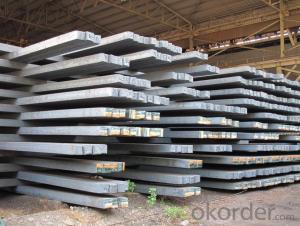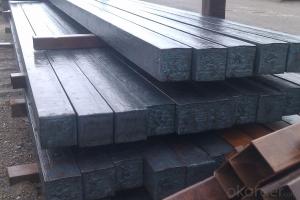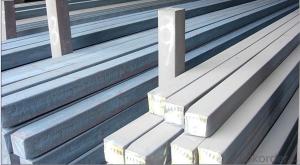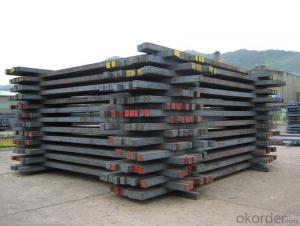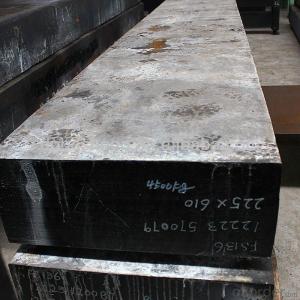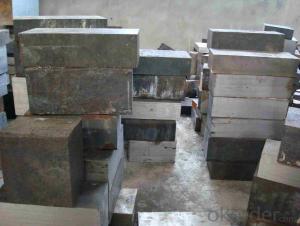Prime square alloy steel billet 125mm Q235
- Loading Port:
- Shanghai
- Payment Terms:
- TT OR LC
- Min Order Qty:
- 100 m.t.
- Supply Capability:
- 10000 m.t./month
OKorder Service Pledge
OKorder Financial Service
You Might Also Like
Structure of Prime square alloy steel billet 125mm Q235

Description of Prime square alloy steel billet 125mm Q235
1. Prepainted steel coil is coated with organic layer, which provides higher anti-corrosion property and a longer lifespan than that of galvanized or galvalume steel sheets.
2. The base metals for prepainted steel coil consist of cold rolled, HDGI Steel, electro-galvanized and hot-dip alu-zinc coated steel. The finish coats of prepainted steel coil can be classified into groups as follows: polyester, silicon modified polyesters, polyvinylidene fluoride, high-durability polyester, etc.
3. The production process has evolved from one-coating-and-one-baking to double-coating-and-double-baking, and even three-coating-and-three-baking.
4. The color of the prepainted steel coil has a very wide selection, like orange, cream-colored, dark sky blue, sea blue, bright red, brick red, ivory white, porcelain blue, etc.
5. The prepainted steel coils can also be classified into groups by their surface textures, namely regular prepainted sheets, embossed sheets and printed sheets.

Main Feature of Prime square alloy steel billet 125mm Q235
Uncoated CR steel sheet
With the features of in line with the international highest standards in demension and shape, excellent surface finish and properties, the products are mainly used in home appliance and automobile industries.
Galvanized steel sheet(include HDG and EG)
With the features of good corrosion resistance, the products are mainly used in automobile, home appliance, electronics, building and machinery manufacture industries, etc.
Precoated steel sheet
With the features of enviromental protection and good processablility, long lasting surface durability, rich in colors, the products are maily used in building, home appliance and furniture industries, etc.
Applications of Prime square alloy steel billet 125mm Q235
Manufacture Progress:HRC-CRC-GALVANIZED-COLOR COATED
Application : Construction, electrical, transportation, steel plant, composite board plant, steel tile factory
Payment & Shipping Terms:T/T ,L/C, and FOB CHINA
Minimum Order Quantity: 25Tons
Packge Type: Moisture-proof paper inner,Steel outside,Bundle by steel rope.
Package in Container : Wood as a foot pad, wire rope reinforcement,PPGI steel coil tied together by steel rope.

Specifications of Prime square alloy steel billet 125mm Q235
Product | Billet |
Material Grade | SGCC / SGCH / DX51D+AZ, etc |
Thickness | 0.6-3.0mm |
Width | 500-1500mm |
Tolerance | Thickness: +/-0.02mm , Width:+/-2mm |
Zinc-coating | Z30-150g/m2 |
Technique | Raw material: Hot rolled steel coil --> Cold rolled_>hot dipped galvalume |
Surface | Dried, Chromated, Unoiled |
Spangle | Regular spangle , small spangle, zero spangle |
ID | 508MM 610MM |
Coil weight | 1-25MT |
Export package | Cardboard inner sleeves, Waterproof paper, galvanized steel covered and steel strip packed |
FAQ of Prime square alloy steel billet 125mm Q235
We have organized several common questions for our clients,may help you sincerely:
1. How Can I Visit There?
Our company is located in Tianjin City, China, near Beijing. You can fly to Tianjin Airport Directly. All our clients, from home or aboard, are warmly welcome to visit us!
2. How Can I Get Some Sample?
We are honored to offer you sample.
3. Why choose CNBM?
we always fix steel produce in container well to make it safe arrive at destination port
we always provide best and professional forward service for our buyer
we always apply 14days free detention for our buyers container in destination
we provide one set After-sales service for our buyer
we provide China inland steel market price report
we help our buyer become number one in local market .
- Q:What are the main factors affecting the hardenability of stainless steel billets?
- The hardenability of stainless steel billets, which refers to the material's ability to be hardened through heat treatment, can be influenced by various factors. These factors include: 1. Alloy composition: The composition of stainless steel, especially the presence of carbon, chromium, nickel, and molybdenum, plays a crucial role in determining its hardenability. Higher carbon content generally improves hardenability, while elements like chromium and nickel enhance corrosion resistance but may decrease hardenability. 2. Grain size: The grain size of stainless steel billets affects the rate and depth of hardening. Finer grain structures typically exhibit better hardenability compared to coarser ones. This is because smaller grains allow for a more even distribution of carbon and alloying elements, resulting in improved hardening response. 3. Heat treatment conditions: The specific heat treatment process utilized, including heating and cooling rates, soaking time, and quenching media, has a significant impact on the hardenability of stainless steel billets. Proper control of these parameters is essential to achieve the desired hardness and mechanical properties. 4. Cooling rate: The rate at which the billets are cooled during the quenching process is a critical factor in determining their hardenability. Rapid quenching, such as water or oil quenching, promotes martensitic transformation and leads to greater hardness. Slower cooling rates, such as air cooling, result in a softer and less hardened structure. 5. Cross-sectional thickness: The thickness of the stainless steel billets also affects their hardenability. Thicker sections tend to have lower hardenability due to slower heat transfer rates during quenching. Conversely, thinner sections can achieve higher hardness levels due to faster cooling rates. 6. Prior microstructure: The initial microstructure of the stainless steel billets, whether they are in an annealed or cold-worked state, can influence hardenability. Cold work can introduce dislocations and grain boundaries, which may impede the diffusion of carbon and alloying elements during heat treatment, leading to reduced hardenability. Considering these factors, manufacturers and engineers must carefully select stainless steel grades and tailor the heat treatment process to achieve the desired level of hardenability and mechanical properties in stainless steel billets.
- Q:How are steel billets inspected for quality control?
- Steel billets are inspected for quality control through a series of rigorous tests and inspections. The process starts with visual inspection, where the billets are examined for any visible defects or irregularities in shape, size, surface finish, or any signs of cracks or inclusions. After the visual inspection, the billets undergo various non-destructive testing techniques such as ultrasonic testing (UT) and magnetic particle inspection (MPI). UT uses high-frequency sound waves to detect any internal flaws or defects in the billets, while MPI uses magnetic fields and iron particles to identify surface cracks or discontinuities. In addition to non-destructive testing, destructive tests are also conducted to assess the mechanical properties of the billets. These tests include tensile testing, where a sample is subjected to tension until it breaks to measure its strength and elongation properties. Hardness testing is performed using various methods like Rockwell or Brinell tests to determine the billet's resistance to indentation or deformation. Chemical analysis is another critical aspect of quality control. Samples are taken from the billets and subjected to spectroscopic analysis to determine the chemical composition, ensuring that it meets the required specifications and standards. Furthermore, dimensional measurements are carried out to verify the billets' accuracy in terms of length, diameter, and other dimensional tolerances. This is done using precision measuring tools such as micrometers and calipers. Overall, a combination of visual inspection, non-destructive testing, destructive testing, chemical analysis, and dimensional measurements is employed to ensure the quality of steel billets. These comprehensive quality control measures help identify any defects or inconsistencies, guaranteeing that the billets meet the required standards and are suitable for further processing in the steel industry.
- Q:How are steel billets used in the manufacturing of packaging materials?
- Steel billets are often used in the manufacturing of packaging materials due to their durability and strength. These billets, which are essentially semi-finished steel products, serve as the raw material for various packaging products such as cans, drums, and containers. To manufacture packaging materials, the steel billets are first heated to a specific temperature, allowing them to be easily shaped and molded. They are then passed through a series of rolling mills, where they are flattened and elongated into the desired shape and size. This process, known as hot rolling, helps to improve the mechanical properties of the steel and increase its strength. Once the steel billets have been transformed into the desired shape, they are further processed and coated to enhance their corrosion resistance and provide a smooth surface finish. This coating can be a layer of tin, lacquer, or polymer, depending on the specific packaging requirements. The finished steel packaging materials offer a wide range of advantages. They are strong and durable, providing excellent protection to the products they contain. They are also impermeable to moisture, gases, and light, ensuring the preservation and freshness of the packaged goods. Additionally, steel packaging materials are 100% recyclable, making them an environmentally friendly choice for packaging solutions. In summary, steel billets are an essential component in the manufacturing of packaging materials. By undergoing various shaping, rolling, and coating processes, these billets are transformed into strong and durable packaging products that provide excellent protection and preservation for a wide range of goods.
- Q:How are steel billets used in the manufacturing of medical equipment?
- Steel billets are used in the manufacturing of medical equipment as a raw material that can be shaped and machined into various components such as surgical instruments, implants, and medical device casings. The high strength and durability of steel make it suitable for producing equipment that requires precision, reliability, and resistance to corrosion.
- Q:What are the different types of steel used in manufacturing steel billets?
- There are several different types of steel used in the manufacturing of steel billets. Some of the most common types include carbon steel, stainless steel, alloy steel, and tool steel. 1. Carbon Steel: This is the most commonly used type of steel for manufacturing steel billets. It contains a small amount of carbon, typically around 0.05% to 0.25%, which gives it its strength and durability. Carbon steel is versatile and can be used in a wide range of applications. 2. Stainless Steel: Stainless steel is known for its corrosion resistance and high strength. It contains chromium, which forms a protective oxide layer on the surface, preventing rust and corrosion. Stainless steel is often used in applications where resistance to moisture and chemicals is required, such as in the construction of bridges and buildings. 3. Alloy Steel: Alloy steel is made by adding various alloying elements to carbon steel, such as manganese, nickel, chromium, and molybdenum. These elements enhance the steel's properties, such as its strength, hardness, and resistance to wear and tear. Alloy steel is commonly used in the automotive and aerospace industries. 4. Tool Steel: Tool steel is specifically designed to have high hardness, abrasion resistance, and the ability to withstand high temperatures. It is often used in the production of cutting tools, molds, and dies. Tool steel is typically made with a combination of alloying elements, such as tungsten, vanadium, and cobalt. These are just a few examples of the different types of steel used in the manufacturing of steel billets. The selection of the specific type of steel depends on the desired properties and the intended application of the steel billets.
- Q:How are steel billets used in the manufacturing of wire products?
- Steel billets are an essential component in the manufacturing of wire products. They serve as the starting material for the wire production process. Steel billets are semi-finished products that are typically cast in a rectangular or square shape. These billets are made from molten steel that is solidified and then subjected to various shaping processes to form the desired dimensions. The first step in using steel billets for wire production involves heating them in a furnace to a specific temperature. This heating process, known as annealing, helps soften the steel and make it more malleable. By doing so, it becomes easier to shape the billets into wire forms. Once the billets have been heated and softened, they are then passed through a series of rollers and drawing dies. These machines gradually reduce the cross-sectional area of the billets, elongating them into the desired wire diameter. The process of reducing the diameter of the billets is called wire drawing. During the wire drawing process, the steel billets undergo multiple passes through the rollers and drawing dies. Each pass reduces the diameter of the billets further until they reach the desired wire size. This continuous reduction in diameter also improves the mechanical properties of the wire, such as its tensile strength and ductility. After the wire drawing process, the steel wire is typically coiled onto spools or reels for further processing or distribution. Depending on the intended application, the wire may undergo additional treatments, such as heat treatment or surface coating, to enhance its properties or protect it from corrosion. In summary, steel billets are used in the manufacturing of wire products by being heated, shaped, and drawn through rollers and dies to reduce their diameter and transform them into wire forms. This process allows for the production of wires with various dimensions and properties, making them suitable for a wide range of applications in industries such as construction, automotive, electrical, and manufacturing.
- Q:How do steel billets contribute to the overall strength of a finished product?
- Steel billets are an essential component in the manufacturing process of various steel products, and they play a crucial role in determining the strength of the finished product. The strength of a final steel product is primarily dependent on the quality of the steel billets used. Firstly, steel billets are made by continuously casting molten steel into solid blocks or forms. This process ensures that the steel billets have a consistent and uniform structure, which is vital for maintaining the overall strength of the finished product. The uniformity of the steel billets allows for a more even distribution of stress and load-bearing capacity throughout the final product. Moreover, steel billets are usually made from high-quality steel alloys that are specifically chosen for their superior strength properties. These alloys typically contain elements such as carbon, manganese, and other alloying elements that enhance the overall strength and hardness of the steel. By using high-quality steel billets, manufacturers are able to produce finished products that exhibit excellent tensile and yield strength, making them more resistant to deformation, bending, and breaking. Additionally, steel billets undergo various heat treatment processes, such as quenching and tempering, which further enhance their strength. Quenching involves rapidly cooling the billets to increase their hardness, while tempering reduces the brittleness and improves their toughness. These heat treatment processes result in steel billets with improved mechanical properties, including higher yield strength and improved resistance to fatigue and impact. Furthermore, the size and shape of steel billets also contribute to the overall strength of the finished product. The dimensions of the billets determine the final dimensions of the product, and a larger billet size allows for a more substantial and stronger end product. Similarly, the shape of the billets can be optimized to improve the load-bearing capacity and structural integrity of the finished product. In conclusion, steel billets are critical to the overall strength of a finished product. Through their uniform structure, high-quality alloys, heat treatment processes, and optimized size and shape, steel billets provide the necessary foundation for the production of strong and durable steel products. Selecting the right steel billets and ensuring their quality throughout the manufacturing process are vital steps in creating a finished product with exceptional strength and performance.
- Q:Can steel billets be used in the manufacturing of machinery?
- Steel billets have the capability to be utilized in the production of machinery. These semi-finished metal products are typically either hot rolled or forged into various shapes, such as bars, rods, or sheets. Machinery components like gears, shafts, bearings, and structural frames are manufactured using these billets as the raw material. The utilization of steel billets in machinery manufacturing offers numerous benefits. Steel is renowned for its exceptional strength, durability, and resistance to wear, making it a suitable choice for heavy-duty applications. Furthermore, steel can be easily machined, welded, and molded into intricate shapes, facilitating the production of complex machinery parts. Moreover, due to its high melting point and thermal conductivity, steel is an ideal material for applications involving high temperatures or requiring heat transfer. Overall, steel billets are extensively employed in machinery manufacturing due to their outstanding mechanical properties, versatility, and dependability.
- Q:What is alpha carbon? What is beta carbon?
- The method of marking C is generally used in organic matter, and the C atom directly connected with the functional group is called alpha carbon.
- Q:What are the different types of forging processes used for shaping steel billets?
- There are several different types of forging processes that are commonly used for shaping steel billets. These processes include open die forging, closed die forging, and ring rolling. Open die forging is a process in which the steel billet is placed between two flat dies and compressed to shape it. This process is commonly used for larger and simpler shapes, as the steel is not completely enclosed by the dies, allowing for more flexibility in the final shape. Closed die forging, also known as impression die forging, involves the use of specially designed dies that contain cavities in the shape of the desired final product. The steel billet is placed between these dies and compressed, causing the metal to flow and take on the shape of the cavities. This process is commonly used for more complex shapes and allows for greater precision and control over the final product. Ring rolling is a forging process used specifically for shaping steel billets into rings. The billet is placed on a mandrel, and a series of rollers apply pressure to the billet, causing it to deform and take on the shape of a ring. This process is commonly used in the production of seamless rolled rings, which are widely used in industries such as aerospace, oil and gas, and power generation. Overall, these different types of forging processes offer various advantages and are chosen based on the complexity of the desired shape, the required precision, and the specific requirements of the end application.
1. Manufacturer Overview |
|
|---|---|
| Location | |
| Year Established | |
| Annual Output Value | |
| Main Markets | |
| Company Certifications | |
2. Manufacturer Certificates |
|
|---|---|
| a) Certification Name | |
| Range | |
| Reference | |
| Validity Period | |
3. Manufacturer Capability |
|
|---|---|
| a)Trade Capacity | |
| Nearest Port | |
| Export Percentage | |
| No.of Employees in Trade Department | |
| Language Spoken: | |
| b)Factory Information | |
| Factory Size: | |
| No. of Production Lines | |
| Contract Manufacturing | |
| Product Price Range | |
Send your message to us
Prime square alloy steel billet 125mm Q235
- Loading Port:
- Shanghai
- Payment Terms:
- TT OR LC
- Min Order Qty:
- 100 m.t.
- Supply Capability:
- 10000 m.t./month
OKorder Service Pledge
OKorder Financial Service
Similar products
New products
Hot products
Related keywords
